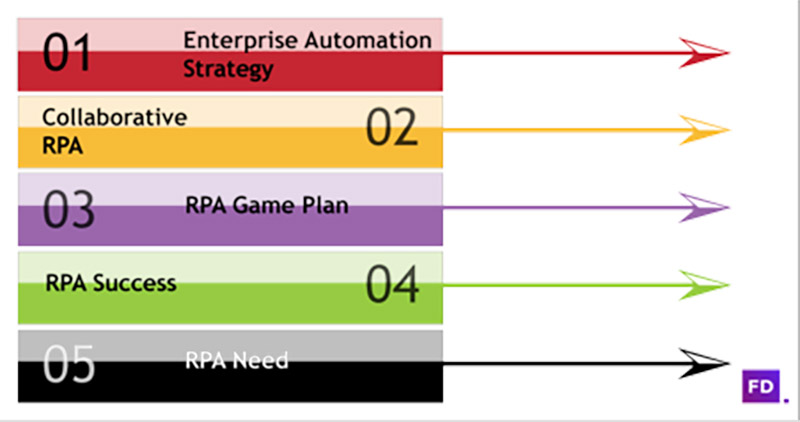“When I began my career in the IT field 20 years ago, I thought that the REAL digital world was simply comprised of 1.42 MB Floppy disks. Since then, the world of digital business has been revolutionized time and time again, continuously accelerating technological progress like never before. Now, we stand at the summit of an uncertain but incredibly advanced future to be driven by the advent of Robotics Process Automation (RPA) in business. In what follows, the Fulcrum Team will discuss the top 5 issues preventing businesses from moving towards robotic process automation, and demystify the incorrect assumptions surrounding the subject. But first we’ll give quick history of the computing landscape.” Bimal Panchasara
Digital Transformation: Getting Up To Speed
Today, technology is changing, growing, and evolving every second. Data volumes are just picking up at their peak. Cellphones, computers, digital factories, robots, autonomous cars, and even drones have become routine technologies, with full-scale implementation across the industry. The great innovators who brought these technologies to the fore are already striving for the next reinvention phase — mass adoption and usage – which we will surely experience very soon. The advent of this new digitally enhanced business age will be yet another stage in the long history of digital transformation.
The way we view the history of digitally enabled business, Digital Transformation 1.00 was all about using IBM mainframes to execute fast and effective processing; to make internal business operations easier. Digital Transformation 2.00 was all about the mass availability of technology and information over the Internet; making everything accessible to everyone. Now, Digital Transformation 3.00 comes in, presenting a full-fledged, end-to-end integration of the entire world! (And, by the way, we believe Digital Transformation 4.00 and 5.00 are just a half-decade away).
Throughout this entire journey, the role of humans in this equation has become increasingly crucial. As the driver of technological advancement, we continue enhancing technology, step-by-step, to uplift the human race into the next age of business and lifestyle. As a result, we’re left to wonder: “What’s next?” -– especially when you hear news like “one of the leading broker companies is going to hire more digital ROBOTS than HUMANS in the year 2019.”
When we step outside of our daily use of technology, we can clearly see the big picture. We must now take a more interesting and strategic role at the level of the masses, in a variety of areas like healthcare and innovation. We must also use the technology we currently have and work toward solving larger problems like water, food, agriculture, environment loss, global warming, global pollution, poverty, etc. To achieve this shift, there is a need for changing massive human efforts from routine, repetitive employment tasks to a new way of thinking and working via disruptive technology.
Physical robots made their way into manufacturing tasks that were previously held by humans long ago. Now we’ve entered the paradigm of software robots, with full capabilities and major implications for the future. Across industries, all organization have rushed to thinking about how software robots can make their lives easier and their businesses more profitable. The robots are being used to replace many mundane, repetitive tasks, so companies can leverage their human capital to tackle strategic tasks. We have observed that this “RUSH thinking approach” has a variety of challenges, including overcoming certain myths and incorrect assumptions.
In order to bring clarity, we would like to summarize five key points regarding the above approach for robotics process automation (RPA).

The Truth About RPA Implementation:
Question 1: Should RPA be part of my digital transformation strategy (or Enterprise Automation Strategy), or a loosely-developed silo initiative?
This is the key question every organization should debate and think through. Looking at levels 1 to 5 of the3 RPA journey, the more you advance, the more you will need to integrate RPA into machine learning, AI, and data analytics. The moment this need arises; you will realize how the entire ecosystem of your company’s digital platforms needs to align with this requirement. If you have done one simple POC and try to move forward, you will struggle immensely when it comes to multiple robots to be developed together (or run together, or integrated together).
The first step, for any organization, should be to define the overall digital transformation journey for the company and the customer experience journey. Your RPA approach should be linked to these journeys, with tight integration points. To make it a long-term sustainable implementation with high ROI, you must ensure your future as a truly ‘Digital Workforce Team.’ Complete alignment between business and IT is paramount to achieve highly-effective change management, with a focus on the cultural impact. If done strategically, and carefully, this will allow companies to create true digital culture within the organization.
Question 2: Is my RPA a “Collaborative RPA” working with humans, or is it being developed against them?
This is a classic dilemma for most business leaders. All of us have fears regarding how this would impact the current workforce/employment, etc. and whether this would really end up as cost saving against human cost.
We should look at this from three perspectives:
Technological evolution has been happening for centuries, not only today. Humans have always carved out a niche for themselves to go to a whole new level of contribution to the human race. It’s nothing to worry about!
Every company struggles to get the necessary bandwidth to run wide-ranging strategic initiatives. Even more so when trying to focus on improving business operations. A large percentage of operations employees are typically underutilized or have high potential, but they are stuck managing routine, mundane jobs. This is a perfect opportunity to shift an organization’s existing talent into the right direction while saving on cost.
Repeat work and the accuracy of human-based business processes are one of the biggest challenges for any company. Additionally, there are very limited means for tracking what went wrong and where human process associates need to improve. RPA delivers great logs for all processes/tasks and can correct itself on a continuous basis to bring almost 100% accuracy in its tasks (once assigned), along with literally no onboarding effort. Current teams can elevate themselves to monitor and work on a hybrid model with all digital process robots to make sure that they continuously learn and deliver optimum productivity (through this new digital channel).
Question 3: Should I spend more time asking, “What is the best RPA tool?” OR “What is the game plan for my organization?”
(Finding the effective RPA strategy leveraging RPA Center of Excellence):
When we at Fulcrum receive inquiries about our RPA services, the first question we usually hear is – “Which tool do you recommend to use during RPA implementation?” However, this is a trick question… Our experience says: the more you grow into RPA implementation, inevitably, you will start leveraging multiple RPA tools; picking and choosing depending on various processes you require and the complexity involved.
We recommend, first, that all processes be analyzed and putting together an expected feature/complexity model against its RPA implementation. This will give you a good idea of whether one tool will do the job or multiple tools will be required. It is more like determining whether you need one coder/skill or would you need multiple different skills of coding to make one software/process run.
The best way to have this continuous RPA evaluation, is to implement an end-to-end RPA COE within the organization. This COE can develop talents, process, and governance while also targeting for cost-saving ROI and number of processes to be brought into RPA umbrellas (like a hiring manager for digital robots.)
Question 4: Should I have some defined evaluation criteria for my RPA’s success at an early stage, or should it be agile during the early execution phase?
Most companies exploring RPA find it difficult to establish ROI because traditional measures often do not justify the deployment cost, according to the Institute for Robotic Process Automation and Artificial Intelligence.
While the institute estimates RPA deployments bring 20 to 25 percent cost savings on average (We have seen even 50-90% cost savings too for many use cases), there’s more to measure than the just the fiscal impact.
When thinking about critical measurements, it’s important to analyze how much time it takes to go from an input to an output in a back-office process, while also looking at how much time the overall back-office process takes. This helps to measure the start time and stop time of a back-office process before and after an RPA deployment. From here, you can compare the result to calculate the real-time benefits ROI.
Another good ROI indicator is productivity — measuring the length of time human workers spend on a task versus how quickly robots can complete that same task. It’s also important to track and compare quality (accuracy) and compliance accuracy. Now, the real question is: “Should there be a framework as a base version to analyze the current status of these parameters and evolve it to fine-tune for accurate ROI calculations?”
Try to think about potential situations like if a new recruit has been hired. How would you measure his or her performance in the first 90 days vs. over the year or even across multiple years? We should apply similar types of logic to evaluate newly developed digital robots and have realistic expectations.
Question 5: Does my industry/business function really need RPA, or it is only for those who want to invest in RPA? Who needs RPA?
Who should initiate RPA within the organization? If I am from the marketing group, do I really need RPA? If I am from sales, do I really need RPA? If I am in the education or manufacturing industry, do I really need RPA? The answer is simple: YES! The question is not about if you need RPA; the question is: “What processes would benefit from intelligent automation and increase your group’s effectiveness? How burdened are you with repetitive and time-consuming processes? The answers to these questions will give you the insight needed to identify areas where you can take advantage of RPA.
Looking at the speed with which RPA tools are inventing new intelligent features, most of the processes workers are manually executing could be migrated into digital robotic delivery. Every single process that a human is delivering is a probable candidate for RPA in the current digital world; e.g. RPA for the insurance industry, value chain processes from sales to claims to reinsurance processes; RPA for banking; back-end office processes; RPA for back-end processes for retail industry eco-system. And the list goes on.
Keeping in mind the above key perspectives, consider that 1 industry physical robot for 1000 people can reduce overall average wages in an industry by .5 percent). As such, think about how digital robots would impact the employment rate, the future of getting work done, wages and costs of processes, tax systems, BPO industry, and digital transformation of your organization in both the short-term and the long-term.
CXOs can no longer afford to ignore this automation technology and its impact on their company’s growth and profit — or on the potential impact on industry overall. In our opinion, it’s better to take advantage of RPA as early as possible by planting all the right RPA seeds and automation strategy (infrastructure, governance, software, hardware, a maturity model, and setting up COE) to make your organization ready for next wave of the digital workforce.
